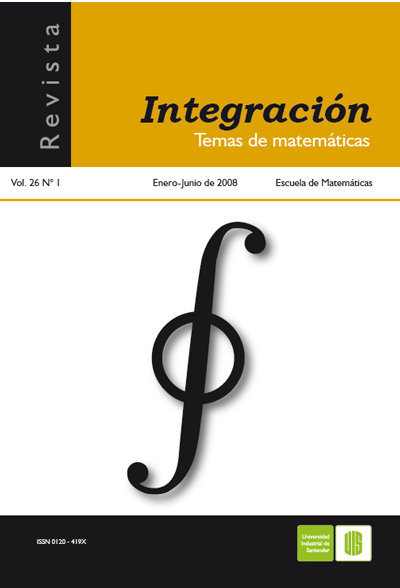Artículos científicos
Publicado 2008-02-29
Palabras clave
- Conjuntos difusos,
- Multifunciones,
- Variable difusa aleatoria,
- Teorema de Negoita-Ralescu
Cómo citar
Reátiga Villamizar, A. (2008). Una nota sobre la integración de una variable difusa aleatoria. Revista Integración, Temas De matemáticas, 26(1), 47–60. Recuperado a partir de https://revistas.uis.edu.co/index.php/revistaintegracion/article/view/57
Resumen
El objetivo de este artículo es definir la integral difusa multívoca como una aplicación del Teorema de Negoita-Ralescu [7], [4]. Para definir la integral difusa multívoca, hacemos una revisión de los aspectos básicos de la Teoría de multifunciones.
Descargas
Los datos de descargas todavía no están disponibles.
Referencias
[1] J.P. Aubin & H. Frankowska, Set-valued Analysis. Birkauser,(1990).
[2] Robert G. Bartle, The Elements of Integration and Lebesgue Measure. John Wiley & sons, New York, 1996.
[3] N. Cáseres, Espacios y convergencia de conjuntos difusos. Monografía, Licenciatura en Matemáticas, UIS, 2006.
[4] P. Diamond & P. Kloeden, Metric Spaces of Fuzzy Sets: Theory and Applications. World Scientific Pub., Singapure, 1993.
[5] M. Kisielewics, Differential inclusions and optimal control. Kluwer, Warzawa, 1991.
[6] E. Klein & A. Thompson, Theory of Correspondences. Wiley, New York, 1984.
[7] M. Puri & Dan Ralescu, “Fuzzy Random Variables”, Journal of Mathematical Analysis and Applications, 114(1986), 409-422.
[8] Marko A. Rojas-Medar, Análisis Fuzzy Multívoco, Universidad de Estadual de Campinas-SP, Brasil. Depto. de Matemáticas Aplicada IMECC, 2003.
[9] Lofti Zadeh, “Fuzzy sets”, Information & Control, 8 (1965), 338-353.
[2] Robert G. Bartle, The Elements of Integration and Lebesgue Measure. John Wiley & sons, New York, 1996.
[3] N. Cáseres, Espacios y convergencia de conjuntos difusos. Monografía, Licenciatura en Matemáticas, UIS, 2006.
[4] P. Diamond & P. Kloeden, Metric Spaces of Fuzzy Sets: Theory and Applications. World Scientific Pub., Singapure, 1993.
[5] M. Kisielewics, Differential inclusions and optimal control. Kluwer, Warzawa, 1991.
[6] E. Klein & A. Thompson, Theory of Correspondences. Wiley, New York, 1984.
[7] M. Puri & Dan Ralescu, “Fuzzy Random Variables”, Journal of Mathematical Analysis and Applications, 114(1986), 409-422.
[8] Marko A. Rojas-Medar, Análisis Fuzzy Multívoco, Universidad de Estadual de Campinas-SP, Brasil. Depto. de Matemáticas Aplicada IMECC, 2003.
[9] Lofti Zadeh, “Fuzzy sets”, Information & Control, 8 (1965), 338-353.
